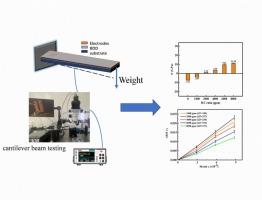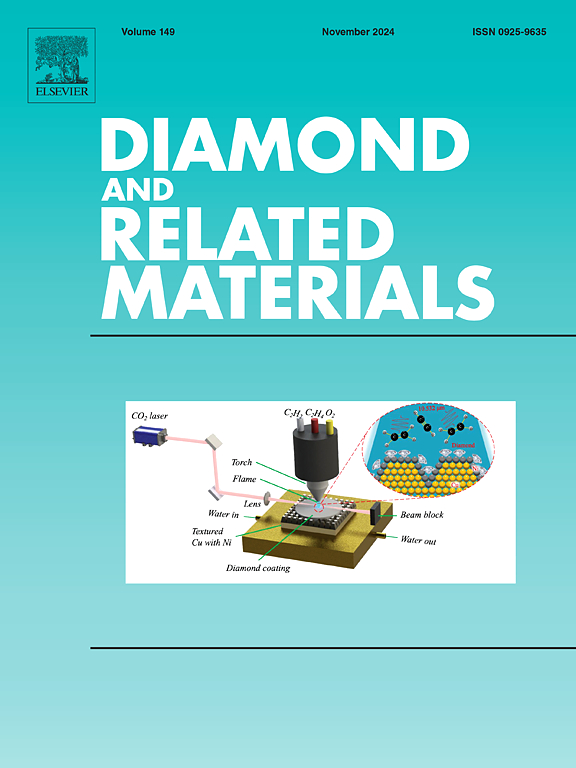残余应力与掺硼金刚石薄膜压阻特性的相关性
IF 5.1
3区 材料科学
Q2 MATERIALS SCIENCE, COATINGS & FILMS
引用次数: 0
摘要
为了研究残余应力对掺硼金刚石(BDD)薄膜压阻行为的影响,我们使用热丝化学气相沉积(HFCVD)系统在硅和金刚石基底上合成了不同掺杂浓度的 BDD 薄膜。研究了 BDD 电极的表面形貌、结构组成、电阻率和压阻特性之间的关系,并深入分析了硼掺杂水平对这些特性的影响。使用扫描电子显微镜(SEM)、原子力显微镜(AFM)和拉曼光谱对 BDD 薄膜的微观结构和键合状态进行了表征。采用悬臂梁弯曲法评估了 BDD 薄膜的压阻特性。我们的研究结果表明,硼掺杂水平不仅会影响电阻率,还会直接影响 BDD 薄膜中的残余应力,这两个因素都会对其压阻特性产生影响。尽管在相同的硼掺杂浓度下,在金刚石衬底上生长的 BDD 薄膜与在硅衬底上生长的 BDD 薄膜相比,晶粒尺寸明显更大,但它们在残余应力和规整因子 (GF) 值方面却表现出一致的变化。随着掺杂水平的增加,绝对残余应力最初会减小,然后再增大;此外,当掺杂水平达到 2000 ppm 时,残余应力会从压应力过渡到拉应力。GF 值与残余应力的大小和类型密切相关。利用 2000 ppm 的掺杂浓度在金刚石基底上生长,我们获得了 257 的 BDD 薄膜峰值 GF 值,凸显了其在压力传感器应用中的巨大潜力。本文章由计算机程序翻译,如有差异,请以英文原文为准。

Correlation of residual stress on piezoresistive properties of boron-doped diamond films
To investigate the influence of residual stress on the piezoresistive behavior of boron-doped diamond (BDD) films, BDD films with varying doping concentrations were synthesized using a hot-filament chemical vapor deposition (HFCVD) system on silicon and diamond substrates. The relationship between the surface morphology, structural composition, resistivity, and piezoresistive properties of BDD electrodes was examined, along with an in-depth analysis of the impact of boron doping level on these properties. The microstructure and bonding state of the BDD films were characterized using scanning electron microscopy (SEM), atomic force microscopy (AFM), and Raman spectroscopy. The piezoresistive properties of the BDD films were evaluated employing a cantilever beam bending method. Our findings demonstrate that the level of boron doping not only affects resistivity but also directly influences residual stress in BDD films, both factors having an impact on their piezoresistive properties. Despite significantly larger grain sizes observed in BDD films grown on diamond substrates compared to those grown on silicon substrates at identical boron doping concentrations, they exhibit consistent variations in residual stress and gauge factor (GF) values. With increasing doping levels, the absolute residual stress decreases initially before increasing again; moreover, at 2000 ppm doping level, it transitions from compressive to tensile stress. The GF value is closely associated with both the magnitude and type of residual stress. By utilizing a doping concentration of 2000 ppm for growth on diamond substrates, we achieved a peak GF value of 257 for BDD films which highlights their promising potential for pressure sensor applications.
求助全文
通过发布文献求助,成功后即可免费获取论文全文。
去求助
来源期刊

Diamond and Related Materials
工程技术-材料科学:综合
CiteScore
6.00
自引率
14.60%
发文量
702
审稿时长
2.1 months
期刊介绍:
DRM is a leading international journal that publishes new fundamental and applied research on all forms of diamond, the integration of diamond with other advanced materials and development of technologies exploiting diamond. The synthesis, characterization and processing of single crystal diamond, polycrystalline films, nanodiamond powders and heterostructures with other advanced materials are encouraged topics for technical and review articles. In addition to diamond, the journal publishes manuscripts on the synthesis, characterization and application of other related materials including diamond-like carbons, carbon nanotubes, graphene, and boron and carbon nitrides. Articles are sought on the chemical functionalization of diamond and related materials as well as their use in electrochemistry, energy storage and conversion, chemical and biological sensing, imaging, thermal management, photonic and quantum applications, electron emission and electronic devices.
The International Conference on Diamond and Carbon Materials has evolved into the largest and most well attended forum in the field of diamond, providing a forum to showcase the latest results in the science and technology of diamond and other carbon materials such as carbon nanotubes, graphene, and diamond-like carbon. Run annually in association with Diamond and Related Materials the conference provides junior and established researchers the opportunity to exchange the latest results ranging from fundamental physical and chemical concepts to applied research focusing on the next generation carbon-based devices.
 求助内容:
求助内容: 应助结果提醒方式:
应助结果提醒方式:


